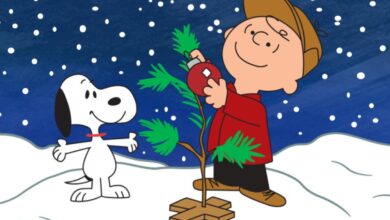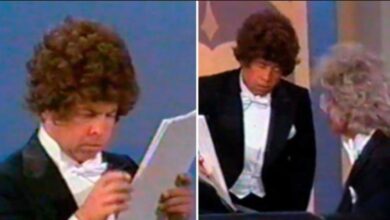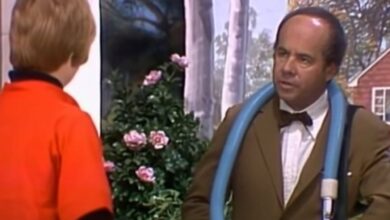The Statler Brothers’ “Flowers on the Wall” Redefined Country Storytelling and Crossed Genre Boundaries in 1965
In late 1965, a curious song titled “Flowers on the Wall” began rising up the charts with quiet but undeniable force. Written by the group’s bass vocalist Lew DeWitt and performed by The Statler Brothers, the song stood out immediately with its mix of sardonic humor, deep melancholy, and a melody that clung to listeners like memory. At a time when the country charts were dominated by earnest heartbreak ballads and honky-tonk tales, “Flowers on the Wall” was something different—a tongue-in-cheek meditation on loneliness that struck a surprisingly universal chord. It became a major hit, reaching No. 2 on the Billboard Hot Country Singles chart and even climbing to No. 4 on the Billboard Hot 100, signaling one of country music’s most unusual and effective crossovers.
The Statler Brothers weren’t a traditional country outfit. Hailing from Staunton, Virginia, they originally formed in 1955 as a gospel quartet known as The Four Star Quartet. The group was named after a brand of facial tissue, a playful start for a group that would come to blend humor and heartbreak with unmatched charm. By the early 1960s, they’d caught the attention of Johnny Cash, who hired them as his backing vocalists. Touring with Cash gave them exposure to wider audiences and solidified their reputation as a unique vocal group capable of harmonies as tight as any gospel ensemble but with a modern, narrative sensibility.
“Flowers on the Wall” came directly from Lew DeWitt’s pen—an oddball song that described a man who insists he’s doing just fine while alone in a room, passing the time by counting flowers on the wall, playing solitaire with a deck of 51, and watching Captain Kangaroo. It was a song of denial—clever, catchy, and laced with a sadness that lingered just beneath the lyrics. Inspired in part by the deadpan comedic style of writers like Ernie Kovacs, the song was also a subtle commentary on isolation, mental distraction, and coping with heartbreak.
The track was produced by Jerry Kennedy at Mercury Records, and its sparse, almost minimalist arrangement helped highlight the group’s layered harmonies and DeWitt’s lead vocal. The snappy rhythm guitar and upright bass gave it a quirky bounce, while the lyrics stayed crisp and up front in the mix. Kennedy, who worked with artists like Tom T. Hall and Roger Miller, knew how to make the unconventional sound commercial—and he delivered again here.
When it hit the airwaves, “Flowers on the Wall” quickly became a sensation. Not only did it climb the country charts, but it also earned the group a Grammy Award for Best Contemporary (R&R) Performance by a Group. That genre-blurring recognition was rare at the time for a country act, especially one with gospel roots. Its chart success proved that country music could be clever, even weird, and still captivate a mainstream audience.
Culturally, the song opened a new lane for storytelling in music. It wasn’t a straightforward heartbreak tale or a triumphant love story—it was about internal struggle, veiled in wit. At a time when male vulnerability was rarely addressed so directly in pop music, The Statler Brothers leaned into it with grace and subtlety, paving the way for artists who would use humor as a vehicle for emotional expression.
The success of “Flowers on the Wall” gave The Statler Brothers a career-defining breakthrough. They moved from being Johnny Cash’s backup singers to major recording artists in their own right. The song’s popularity helped secure their contract with Mercury and ushered in a string of hits that would make them one of the most awarded country groups of all time.
Within the genre, the song had a quiet influence. Its mix of traditional vocal harmony and unusual lyricism encouraged more experimentation in country songwriting. The Statler Brothers proved that storytelling didn’t need to be linear, and that even a playful delivery could mask deep emotion. Their style influenced acts like Alabama and The Oak Ridge Boys, who also blended harmonies with narrative charm.
“Flowers on the Wall” was later covered by a number of artists, but perhaps the most famous usage came decades later in Quentin Tarantino’s 1994 film Pulp Fiction. In the scene where Bruce Willis’s character drives through Los Angeles after a tense encounter, the song plays on the car radio—an ironic backdrop that gave the tune an entirely new cultural moment and introduced it to a younger audience.
Interestingly, around the time the song became a hit, The Statler Brothers were dealing with the pressures of sudden fame. Lew DeWitt, who struggled with Crohn’s disease throughout his life, saw his health begin to decline even as the band was hitting its stride. Still, he remained an integral part of the group’s sound and spirit until his departure in the early 1980s.
Decades later, “Flowers on the Wall” still resonates. It continues to receive radio play, frequently appears on classic country compilations, and remains one of The Statler Brothers’ most beloved recordings. Its presence in pop culture, from radio countdowns to film soundtracks, is a testament to its enduring charm and originality.
Musically, the song helped bridge the gap between country and pop without sacrificing authenticity. It was proof that country didn’t have to conform to Nashville’s typical polish to succeed—quirky, homegrown ideas could cut through if delivered with sincerity and craft.
Though the group received numerous accolades over the years—including induction into the Country Music Hall of Fame in 2008—“Flowers on the Wall” remains the song that introduced their genius to the world. It was their launchpad and their legacy all in one.
In the end, what makes “Flowers on the Wall” unforgettable isn’t just its melody or its lyrics—it’s the way it makes us feel seen. Behind the humor is a very real truth about how we cope with loneliness. The Statler Brothers didn’t just record a hit—they captured a universal experience, wrapped in harmony, and sent it out to the world.
Nearly 60 years after its release, “Flowers on the Wall” still stands as a shining example of country music’s potential to surprise, to comfort, and to endure. It’s a reminder that even the simplest song—when sung with heart—can leave a lasting mark on music history.





